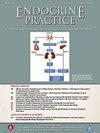Triglyceride to High-Density Lipoprotein Cholesterol Ratio as a Marker of Subclinical Coronary Atherosclerosis and Hepatic Steatosis in Familial Hypercholesterolemia
IF 4.6
3区 医学
Q2 ENDOCRINOLOGY & METABOLISM
引用次数: 0
Abstract
Objective
Features of the cardiometabolic syndrome are prevalent in patients with familial hypercholesterolemia (FH). Triglyceride to high-density lipoprotein cholesterol (TG/HDL-C) ratio, a surrogate marker of insulin resistance, may be a robust predictor of cardiac events in the general population. We explored the association between TG/HDL-C ratio and high-risk coronary artery plaque (HRP) and hepatic steatosis (HS) in asymptomatic patients with FH.
Methods
We conducted a cross-sectional study of 290 patients (mean age = 49 years, 44% male) who underwent computed tomography coronary angiography for cardiovascular risk assessment. HRP and HS were assessed from computed tomography coronary angiography, and TG/HDL-C ratio was derived from the fasting lipid panel collected around time of scanning. Associations were assessed using binary logistic and Kaplan-Meier analysis.
Results
TG/HDL-C ratio was significantly associated with HRP (odds ratio, 1.27; 95% CI, 1.04-1.56; P = .020) and HS (odds ratio, 1.71; 95% CI, 1.17-2.51; P = .005) after adjusting for age, body mass index, smoking, and coronary calcium score. TG/HDL-C ratio was associated with HRP in patients treated with lipid-lowering medications (P = .042) and inclusion in a predictive model outperformed the FH-Risk-Score (area under receiver operating characteristic 0.74 vs 0.63; P = .004). An elevated TG/HDL-C ratio predicted myocardial infarction or coronary revascularization over a median follow-up of 91 months with 10 cardiac events recorded (P = .043). TG/HDL-C ratio was strongly positively correlated (P < .001 for all) with markers of cardiometabolic dysfunction: lipid accumulation product (r = 0.81), visceral adiposity index (r = 0.96), and triglyceride-glucose index (r = 0.91).
Conclusion
TG/HDL-C ratio was strongly associated with HRP, HS, and cardiac events in patients with FH treated with long-term cholesterol-lowering therapy.
甘油三酯与高密度脂蛋白胆固醇(TG/HDL-C)比值作为家族性高胆固醇血症亚临床冠状动脉粥样硬化和肝脂肪变性的标志物
目的:家族性高胆固醇血症(FH)患者普遍存在心脏代谢综合征的特征。甘油三酯与高密度脂蛋白胆固醇(TG/HDL-C)比值,作为胰岛素抵抗的替代指标,可能是普通人群心脏事件的可靠预测指标。我们探讨TG/HDL-C比值与无症状FH患者高危冠状动脉斑块(HRP)和肝脂肪变性(HS)之间的关系。方法:我们对290例患者(平均年龄49岁,44%男性)进行了横断面研究,这些患者接受了ct冠状动脉造影(CTCA)进行心血管风险评估。HRP和HS通过CTCA评估,TG/HDL-C比值通过扫描前后收集的空腹脂质板评估。使用二元逻辑分析和Kaplan-Meier分析评估相关性。结果:TG/HDL-C比值与HRP显著相关(OR: 1.27;95% ci: 1.04-1.56;p=0.020)和HS (OR: 1.71;95% ci: 1.17-2.51;P =0.005),校正年龄、体重指数、吸烟和冠状动脉钙评分。在接受降脂药物治疗的患者中,TG/HDL-C比值与HRP相关(p=0.042),纳入预测模型的效果优于FH-Risk-Score (AUROC为0.74 vs 0.63, p=0.004)。TG/HDL-C比值升高预示心肌梗死或冠状动脉血运重建,中位随访91个月,记录10例心脏事件(p=0.043)。结论:长期接受降胆固醇治疗的FH患者TG/HDL-C与HRP、HS及心脏事件密切相关。
本文章由计算机程序翻译,如有差异,请以英文原文为准。
求助全文
约1分钟内获得全文
求助全文
来源期刊

Endocrine Practice
ENDOCRINOLOGY & METABOLISM-
CiteScore
7.60
自引率
2.40%
发文量
546
审稿时长
41 days
期刊介绍:
Endocrine Practice (ISSN: 1530-891X), a peer-reviewed journal published twelve times a year, is the official journal of the American Association of Clinical Endocrinologists (AACE). The primary mission of Endocrine Practice is to enhance the health care of patients with endocrine diseases through continuing education of practicing endocrinologists.
 求助内容:
求助内容: 应助结果提醒方式:
应助结果提醒方式:


